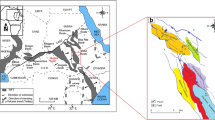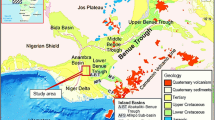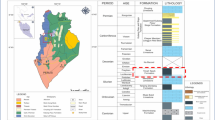Abstract
This paper summarizes the most important results and conclusions derived from organic geochemical investigations performed on the Miocene Aleksinac oil shale (Serbia) during the last 60 years. The Aleksinac oil shale is one of the richest and most studied European oil shale deposits. This paper is divided into four sections. The first section includes data from Rock-Eval pyrolysis, organic petrography, and biomarkers of outcrop samples, as well as samples taken from two layers (upper and lower), drilled from the well BD-4. The results consistently indicated that the Aleksinac oil shale contains immature, mostly algal-derived organic matter (kerogen types I and II), deposited in reducing brackish to freshwater environment. However, certain differences were observed between the upper and lower oil shale sequences in the well BD-4, which resulted in two times higher source potential index in the upper layer. The Aleksinac oil shale has been used as a model substance in numerous organic geochemical studies. The second section of the review paper describes how a standard procedure for determination of kerogen chemical structure (controlled gradual degradation of kerogen by an alkaline permanganate solution) is established, which was developed using the Aleksinac oil shale as a substrate. This oil shale was also used as a model substance to investigate the influences of native minerals on the thermal changes of bitumen and kerogen in sediments, and this process is described in the third section of the paper. In the final section, studies (performed on the Aleksinac oil shale) related to the influence of the pyrolysis type and variations of kerogen type on the yield and composition of liquid pyrolysis products are presented.
Graphical abstract













Similar content being viewed by others
References
Amblès A, Halim M, Jacquesy J-C, Vitorović D, Ziyad M (1994) Characterization of kerogen from Timahdit shale (Y-layer) based on multistage alkaline permanganate degradation. Fuel 73:17–24. https://doi.org/10.1016/0016-2361(94)90183-X
Bajc S, Jovančićević B (2006) Scientific work. In: Čeković Ž, Jovančićević B (eds) Dragomir Vitorović - eighty years of life and work. University of Belgrade, Faculty of Chemistry, Belgrade, pp 101–123
Bajc S, Amblès A, Largeau C, Vitorović DS, D, (2001) Precursor biostructures in kerogen matrix revealed by oxidative degradation: oxidation of kerogen from Estonian kukersite. Org Geochem 32:773–784. https://doi.org/10.1016/S0146-6380(01)00042-0
Bajc S, Amblès A, Vitorović D (2004) Preserved precursors in Pumpherston shale kerogen revealed by oxidative degradation. J Serb Chem Soc 69:923–940. https://doi.org/10.2298/JSC0411923B
Bajc S, Cvetković O, Amblès A, Vitorović D (2008) Characterization of type III kerogen from Tyrolean shale (Hahntennjoch, Austria) based on its oxidation products. J Serb Chem Soc 73:463–478. https://doi.org/10.2298/JSC0804463B
Bajc S (1997) Study of oxidation products of kerogen as precursor indicators. Dissertation, University of Belgrade
Bechtel A, Gratzer R, Sachsenhofer RF, Gusterhuber J, Lücke A, Püttmann W (2008) Biomarker and carbon isotope variation in coal and fossil wood of Central Europe through the Cenozoic. Palaeogeogr Palaeoclimatol Palaeoecol 262:166–175. https://doi.org/10.1016/j.palaeo.2008.03.005
Bechtel A, Oberauer K, Kostić A, Gratzer R, Milisavljević V, Aleksić N, Stojanović K, Groß D, Sachsenhofer RF (2018) Depositional environment and hydrocarbon source potential of the Lower Miocene oil shale deposit in the Aleksinac Basin (Serbia). Org Geochem 115:93–112. https://doi.org/10.1016/j.orggeochem.2017.10.009
Čokorilo V, Lilić N, Purga J, Milisavljević V (2009) Oil shale potential in Serbia. Oil Shale 26:451–462. https://doi.org/10.3176/oil.2009.4.02
Cvetković O, Dragutinović V, Vrvić MM, Curiale JA, Ercegovac M, Vitorović D (1993) Evidence of stable kerogen composition during bacterial depyritization of an oil shale. Org Geochem 20:57–68. https://doi.org/10.1016/0146-6380(93)90081-L
Demaison G, Huizinga BJ (1994) Genetic classification of petroleum systems using three factors: charge, migration and entrapment. In: Magoon LB, Dow WG (eds) The petroleum system—from source to trap. American Association Petroleum Geologists Memoir 60, Tulsa, pp 3–24
Dj S, Vitorović D (1959) Nature of oil-shale kerogen. Oxidations with potassium permanganate in acetone solution. J Chem Eng Data 4:162–167. https://doi.org/10.1021/je60002a015
Dyni JR (2006) Geology and resources of some world oil-shale deposits. U.S. Geological Survey Scientific Investigations Report 2005–5294. U.S. Geological Survey, Reston, Virginia. https://pubs.usgs.gov/sir/2005/5294/pdf/sir5294_508.pdf Accessed 28 Feb 2024
Ercegovac M, Vitorović D, Kostić A, Životić D, Jovančićević B (2009) Geology and geochemistry of the “Aleksinac” oil shale deposit (Serbia). In: Joint 61st ICCP/26th TSOP Meeting, Advances in Organic Petrology and Organic Geochemistry, Gramado, Brazil, Abstracts, p 13
Ercegovac M (1990) Geology of Oil Shales. Građevinska knjiga, Belgrade (in Serbian)
Ficken KJ, Li B, Swain DL, Eglinton G (2000) An n-alkane proxy for the sedimentary input of submerged/floating freshwater aquatic macrophytes. Org Geochem 31:745–749. https://doi.org/10.1016/S0146-6380(00)00081-4
Gajica G, Šajnović A, Stojanović K, Kostić A, Slipper J, Antonijević M, Nytoft HP, Jovančićević B (2017a) Organic geochemical study of the upper layer of Aleksinac oil shale in the Dubrava block (Serbia). Oil Shale 34:197–218. https://doi.org/10.3176/oil.2017.3.01
Gajica G, Šajnović A, Stojanović K, Antonijević M, Aleksić N, Jovančićević B (2017b) The influence of pyrolysis type on shale oil generation and its composition (Upper layer of Aleksinac oil shale, Serbia). J Serb Chem Soc 82:1461–1477. https://doi.org/10.2298/JSC170421064G
Gajica G, Šajnović A, Stojanović K, Schwarzbauer J, Kostić A, Jovančićević B (2022) A comparative study of the molecular and isotopic composition of biomarkers in immature oil shale (Aleksinac deposit, Serbia) and its liquid pyrolysis products (open and closed systems). Mar Pet Geol 136:105383. https://doi.org/10.1016/j.marpetgeo.2021.105383
Glumičić T, Jovančićević B, Milojković S, Nedeljković J, Ercegovac M (1996) Investigation of the origin of Aleksinac oil shale organic matter. J Serb Chem Soc 61:1015–1022
Hertz HS, Andresen BD, Djuričić MV, Biemann K, Šaban M, Vitorović D (1973) The isolation and identification of gamma-lactones in the acidic fraction of Aleksinac (Yugoslavia) shale bitumen. Geochim Cosmochim Acta 37:1687–1695. https://doi.org/10.1016/0016-7037(73)90156-7
International Committee for Coal Petrology (ICCP) (1971) International Handbook of Coal Petrology 2nd Ed, 1st Suppl. Centre Nat. Rech. Sci., Paris
ISO 7404-3 (1984) Methods for the Petrographic Analysis of Bituminous Coal and Antracite. Part 3: Method of Determining Maceral Group Composition. International Organization for Standardization, Switzerland, p 4
ISO 7404-5 (1984) Methods for the petrographic analysis of bituminous coal and antracite. Part 5: Method of determining microscopically the reflectance of Vitrinite. International Organization for Standardization, Switzerland, p 11
Johnson RC, Mercier TJ, Ryder RT, Brownfield ME, Self JG (2011) Assessment of in-place oil shale resources of the Eocene Green River Formation, Greater Green River Basin, Wyoming, Colorado, and Utah. https://pubs.usgs.gov/dds/dds-069/dds-069-dd/REPORTS/69_DD_CH_1.pdf. Accessed 28 Feb 2024
Jovančićević B, Vitorović D (1994) Investigation of the effect of indigenous minerals on carbon isotopic composition (δ13CPDB) of the organic matter of a sediment. J Serb Chem Soc 59:539–545
Jovančićević B, Vitorović D, Šaban M, Wehner H (1992) Evaluation of the effects of native minerals on the organic matter of Aleksinac oil shale based on the composition of free and bound bitumens. Org Geochem 18:511–519. https://doi.org/10.1016/0146-6380(92)90114-D
Jovančićević B, Vučelić D, Šaban M, Wehner H, Vitorović D (1993) Investigation of the catalytic effects of indigenous minerals in the pyrolysis of Aleksinac oil shale substrates: Steranes, triterpanes and triaromatic steroids in the pyrolysates. Org Geochem 20:69–76. https://doi.org/10.1016/0146-6380(93)90082-M
Jovančićević B, Glumičić T, Kašanin M, Polić P, Vitorović D (1996) Bitumen-kerogen and bitumen-mineral interactions in the Aleksinac oil shale. Hem Ind 50:410–413 (in Serbian)
Jovančićević B, Glumičić T, Kašanin M, Polić P, Vitorović D (1997) Interactions of bound bitumen in the Aleksinac oil shale (Yugoslavia). In: 18th International Meeting on Organic Geochemistry, Maastricht, Netherlands, Abstracts, pp 211–212
Kašanin-Grubin M, Glumičić T, Jovančićević B, Obradović J (1997) Investigation of origin and sedimentation conditions of the Aleksinac oil shales on the basis of inorganic and organic matter composition. Ann Géol Penins Balk 61:325–348
Knaus E, Killen J, Biglarbigi K, Crawford P (2010) An overview of oil shale resources. In: Ogunsola OI, Hartstein AM, Ogunsola O (eds) Oil shale: a solution to the liquid fuel dilemma. ACS symposium series. American Chemical Society, Washington DC, pp 3–20
Koopmans MP, de Leeuw JW, Sinninghe Damsté JS (1997) Novel cyclised and aromatised diagenetic products of β-carotene in the Green River Shale. Org Geochem 26:451–466. https://doi.org/10.1016/S0146-6380(97)00025-9
Metzger P, Largeau C, Casadevall E (1991) Lipids and macromolecular lipids of the hydrocarbon-rich microalga Botryococcus braunii. Chemical structure and biosynthesis. Geochemical and biotechnological importance. In: Herz W et al (eds) Progress in the chemistry of organic natural products. Springer Verlag, Berlin, pp 1–70
Mijatović IN, Kapor B, French G, Cha CY (1981) Oil shale inclined modified in situ retorting in Aleksinac basin. Yugoslavia Development Program. In: 6th IASA Resources Conference “World Oil Shale Resources and their Potential Development”, Golden, Colorado
Neto EVDS, Hayes JM, Takaki T (1998) Isotopic biogeochemistry of the Neocomian lacustrine and Upper Aptian marine-evaporitic sediments of the Potiguar Basin, Northeastern Brazil. Org Geochem 28:361–381. https://doi.org/10.1016/S0146-6380(98)00007-2
Peters KE, Walters CC, Moldowan JM (2005) The biomarker guide, vol. 2: biomarkers and isotopes in petroleum exploration and earth history. Cambridge University Press, Cambridge
Petrović M (2012) Reserves report for the Aleksinac oil shale—‘‘Dubrava” block. JP PEU Resavica, p 216. (in Serbian)
Radke M, Willsch H, Welte DH (1980) Preparative hydrocarbon group type determination by automated medium pressure liquid chromatography. Anal Chem 52:406–411. https://doi.org/10.1021/ac50053a009
Schwarzbauer J, Jovančićević B (2015) Fundamentals in organic geochemistry—fossil matter in the geosphere. Springer, Heidelberg
Summons RE, Powell TG (1987) Identification of aryl isoprenoids in source rocks and crude oils: Biological markers for the green sulphur bacteria. Geochim Et Cosmochim Acta 51:557–566. https://doi.org/10.1016/0016-7037(87)90069-X
Taylor GH, Teichmüller M, Davis A, Diessel CFK, Littke R, Robert P (1998) Organic petrology. Gebrüder Borntraeger, Berlin
Tissot BP, Welte DH (1984) Petroleum formation and occurrence, 2nd edn. Springer-Verlag, Heidelberg
U.S. Energy Information Administration (EIA) (2014) Shale oil and shale gas resources are globally abundant. https://www.eia.gov/todayinenergy/detail.php?id=14431#:~:text=Technically%20Recoverable%20Shale%20Oil%20and%20Shale%20Gas%20Resources,of%20world%20shale%20gas%20resources%20%28see%20Table%201%29. Accessed 28 Feb 2024
Vitorović D (1980) Structure elucidation of kerogen by chemical methods. In: Durand B (ed) Kerogen, insoluble organic matter from sedimentary rocks. Editions Technip, Paris, pp 301–338
Vitorović D, Djuričić MV, Ilić B (1974a) New structural information obtained by step-wise oxidation of kerogen from the Aleksinac (Yugoslavia) shale. In: Tissot B, Bienner F (eds) Advances in organic geochemistry 1973. Editions Technip, Paris, pp 179–189
Vitorović D, Djuričić MV, Jovanović L (1974b) Preparation of kerogen concentrate—an important stage in organic geochemical investigation of shale organic matter. Ann Braz Acad Sci (anais Da Academia Brasileira De Ciências) 46:57–62
Vitorović D, Pfendt P, Krsmanović VD (1983) Structural investigation of Aleksinac shale kerogen by chemical and spectroscopic methods. In: Bjorøy M et al (eds) Advances in organic geochemistry 1981. Wiley, Chichester, pp 620–627
Vitorović D, Bajc S, Amblès A (1985) Classification of kerogen from Aleksinac (Yugoslavia) oil shale based on its oxidation products. Croat Chem Acta 58:453–472
Vitorović D, Amblès A, Djordjević M (1986) Improvement of kerogen structural interpretations based on oxidation products isolated from aqueous solutions. Org Geochem 10:1119–1126. https://doi.org/10.1016/S0146-6380(86)80053-5
Vitorović D, Amblès A, Djordjević M, Bajc S (1987) Characterization and classification of kerogens based on oxidation products from multistep alkaline permanganate degradation. Adv Oil Shale Technol, Preprints Symp Am Chem Soc 32:37–42
Vitorović D, Amblès A, Bajc S, Cvetković O, Djordjević M (1988a) The feasibilities of alkaline permanganate degradation method for characterization and classification of kerogens. J Serb Chem Soc 53:175–189
Vitorović D, Amblès A, Bajc S, Cvetković O (1988b) Characterization of kerogen from Messel shale based on multistage alkaline permanganate degradation. Fuel 67:983–993. https://doi.org/10.1016/0016-2361(88)90099-3
Vitorović D, Amblès A, Bajc S, Cvetković O, Polić P (1991) Structural differences between kerogens of the same conventional type demonstrated by their oxidation products. In: Manning DAC (ed) Organic geochemistry—advances and applications in energy and the natural environment. Manchester University Press, Manchester, pp 464–469
Vitorović D, Šaban M (1983) Geolipids in Aleksinac oil shale. In: Miknis FP, McKay JF (eds) Geochemistry and chemistry of oil shales. ACS symposium series 230. American Chemical Society, Washington, pp 37–58
Vitorović D (1956) On the nature of the organic substance of paraffinic shale. Oxidation with potassium permanganate in a neutral medium. Dissertation, University of Belgrade (in Serbian)
Vrvić MM, Vučetić J, Vitorović D (1983) Preparation of rich kerogen concentrate from Aleksinac (Yugoslavia) oil shale involving removal of pyrite with Thiobacillus ferrooxidans. In: Rossi G, Torma AE (eds) Recent progress in biohydrometallurgy. Associazione Mineraria Sarda, Iglesias, pp 527–540
Vučelić D, Marković V, Vučelić V, Spiridonović D, Jovančićević B, Vitorović D (1992) Investigation of catalytic effects of indigenous minerals in the pyrolysis of Aleksinac oil shale organic matter. Org Geochem 19:445–453. https://doi.org/10.1016/0146-6380(92)90011-L
Vučelić D, Marković V, Vučelić V, Spiridonović D, Jovančićević B, Vitorović D (1991) Investigation of catalytic effects of indigenous minerals in the pyrolysis of Aleksinac oil shale organic matter. In: 15th International Meeting on Organic Geochemistry, Manchester, England, Abstracts, p 38
Žujović Z, Srejić R, Vučelić D, Vitorović D, Jovančićević B (1995) Structural analysis of Aleksinac oil shale kerogen using high resolution solid state 13C n.m.r. spectroscopy. Fuel 74:1903–1909. https://doi.org/10.1016/0016-2361(95)80026-E
Žujović Z, Srejić R, Vučelić D, Jovančićević B, Vitorović D (1998) Influence of depyritization on NMR relaxation parameters of Aleksinac oil shale kerogen. Fuel 77:1001–1003. https://doi.org/10.1016/S0016-2361(97)00282-2
Acknowledgements
The support from the Ministry of Science, Technological Development and Innovation of Republic of Serbia (Contract number: 451-03-66/2024-03/200168 and 451-03-65/2024-03/ 200126), is greatly appreciated. We are also grateful to the anonymous reviewers, Editor-in-Chief, Prof. Dr. Ulrich Riller and Guest Editor, Prof. Dr. Jan Schwarzbauer, whose constructive comments and suggestions greatly improved this manuscript, as well as to Dr. Ivan Kojić for technical preparation of Figures 6, 7, 8, 9 and to Dr. Aleksandra Skrobonja for language corrections.
Author information
Authors and Affiliations
Contributions
Branimir Jovančićević provided the idea for the article. The first draft of the manuscript was written by Branimir Jovančićević. Ksenija Stojanović and Dragana Životić supplemented the work and performed the revision of the manuscript. Ksenija Stojanović adopted the paper according to the submission guidelines. All authors commented on previous versions of the manuscript and read and approved the final version of the manuscript.
Corresponding author
Ethics declarations
Conflict of interest
The authors declare that they have no competing financial interests or personal relationships that could have appeared to influence the work presented in this paper.
Additional information
The paper is submitted to the Special Issue of the International Journal of Earth Sciences “From biomolecules and organic matter to sedimentary environments and basin analysis” in honor to University Professor Ralf Littke, Dr. rer. nat.
Rights and permissions
Springer Nature or its licensor (e.g. a society or other partner) holds exclusive rights to this article under a publishing agreement with the author(s) or other rightsholder(s); author self-archiving of the accepted manuscript version of this article is solely governed by the terms of such publishing agreement and applicable law.
About this article
Cite this article
Jovančićević, B., Stojanović, K. & Životić, D. Organic geochemical study of Aleksinac oil shale. Int J Earth Sci (Geol Rundsch) (2024). https://doi.org/10.1007/s00531-024-02413-x
Received:
Accepted:
Published:
DOI: https://doi.org/10.1007/s00531-024-02413-x




